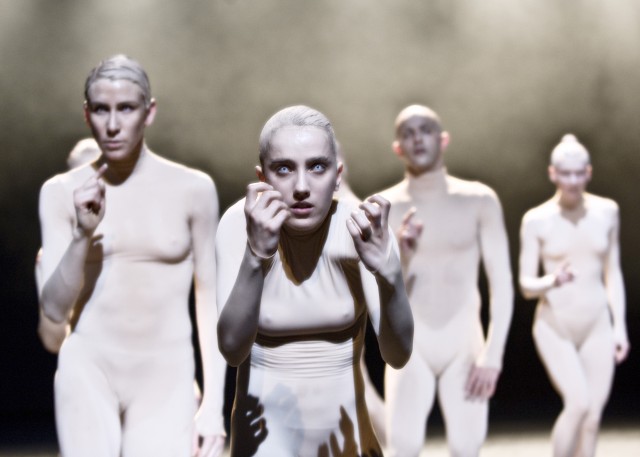Corps de Walk: They Have Landed Walking

Dance House’s presentation of Carte Blanche, a program of the Norwegian National Company of Contemporary Dance
The techno-dance aliens have landed. There are twelve of them. They wear beige unitards, have their hair pasted to their skulls and their eyes whited out. The unitards give them the look of shaven Caucasian babies, with adult sexual organs straining to break free of the latex epidermal membrane.
We first encounter them in a circle, facing in, with their arms outstretched to the heavens, from where they have apparently been teleported to Earth. Nature sounds—birds singing, etc.— fill the air. These are soon obliterated by a machine-made pulse. The techno-babies have come to dance and they prefer to do it in straight time; a militaristic boom, boom, boom remains monotonously present throughout. It’s nothing a hit of ecstasy can’t ameliorate, and of course the ‘rave’ is part of the aesthetic driving Corps de Walk by Israeli choreographer Sharon Eyal, artist Gai Behar, and DJ Ori Lichtik and The Norwegian National Company of Contemporary Dance.
Deriving from the classical ballet term “corps de ballet,” which designates company members who are not soloists, Corps de Walk keeps faith with the Borg-like twelve. The focus is on mechanized unison. The figures point, twitch, jerk, and undulate as one. Syncopated variations are permitted, but these are sympathetic elabourations on the theme rather than defiant gestures of individuated souls seeking freedom from the group. Eyal treats the corps (and I think ‘corps’ carries references to ballet and the military in this piece) as it tends to be treated: a many-bodied entity that must act with one mind.
Overlay this with a DJ mix that samples everything from Debussy to David Byrne, a smorgasbord of styles squished into one square-time dish, and you have the rave element. But it’s a rave for aliens, or for de-humanized humans. The twelve might get to coupling at any moment, but they will certainly skip the foreplay. No wine and poetry to romanticize sexual congress. Of the many carefully spaced, piston-and-gear like movements, it would merely take a shift in orientation and a forward step to fit the male plug into the female socket. Walk, shift, walk, shift, connect parts, discharge emission, disconnect, walk.
Corps doesn’t go that far but such possibilities are slyly implied. I don’t think we’re meant to take the statement of the piece too seriously. There’s a playfulness throughout, one that, even in the regimentation of the dance, allows the individuality of the dancers to subtly emerge. Corps is a fantastical ‘what if’. It plays on dystopian fictions of the 20th century (1984, Brave New World)—in which any individual expression is a threat to the totalitarian regime. In this case the regime seems to be a hybrid of popular dance culture and military organisation. Given the simplicity and persistence of musical rhythm, you can see how the two can go together. Individuals must find fleeting moments of contact within the oppressive beat.
But there is a musical statement being made beyond the rhythmic structure. All the samples are from the last century-and-a-half of musical history. They are also presented, with some exceptions, chronologically. DJ Lichtik seems to be suggesting that our aliens have absorbed recent Western music history and that the dance we are watching is the obvious result of that development. From the late romantic to the Europeanized (read: simplified) African beat: not an unfair picture.
What is a little confusing in this linear progression is choreographer Eyal’s contention that “walks are the new dance.” She writes that, in recent works she uses “walks with a combination of sketched technique” to “create a kind of hi-tech building.” But using everyday walking as the basis for dance is something choreographers were exploring in detail half a century ago. There’s nothing wrong with borrowing from the past, or in finding the “walk” anew, but perhaps the statement is a little bold.
The dancers sure can walk, though. What I found most pleasurable about Corps was the technique of the company members. It’s no small thing to get twelve people to work together with such precision. It takes years of training, absolute focus, and a very Borg-like unity of mind.
Corps de Walk, Dance House’s presentation of Carte Blanche, a program of the Norwegian National Company of Contemporary Dance, performed at the Vancouver Playhouse on March 22 and 23, 2013.



